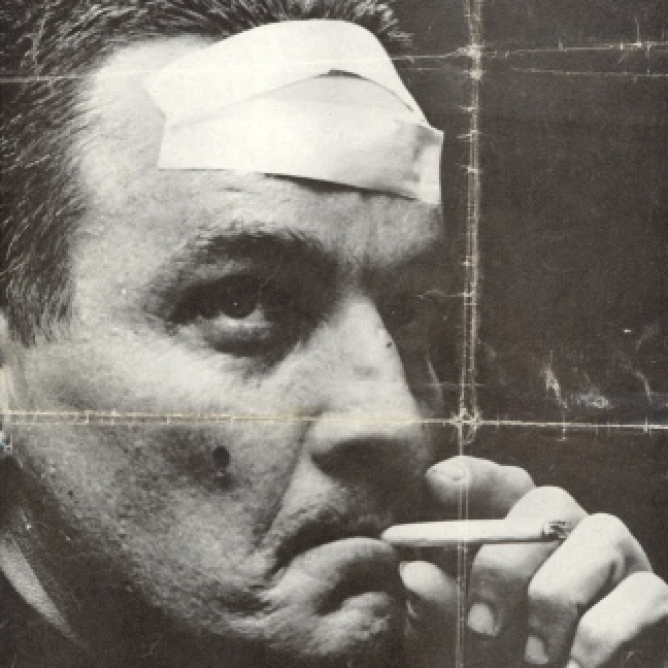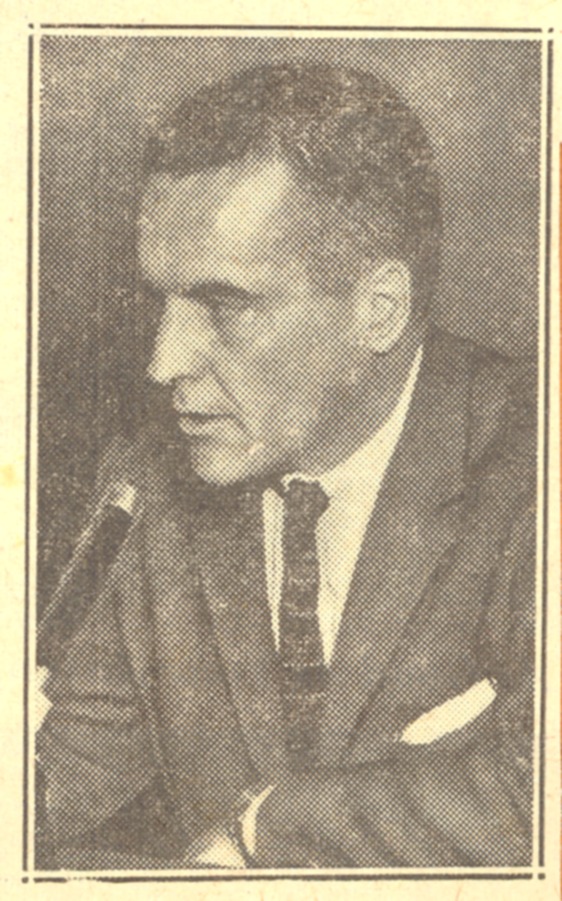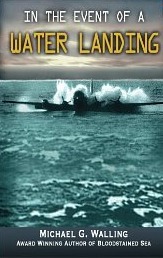Our Anniversary #58 is dedicated to
Captain John D. Murray, our pilot, a true hero . . .
Captain John Murray held 78 lives in the palms of his hands. The weather was horrible. It was dark and the winds were nearly gale force. His Flying Tiger was limping on only one engine. The other three were dead,
It had to be a “white knuckle” flight. He held tight to the controls as he searched the darkness for a suitable stretch of sea to lay the big bird down at its final resting place.
Captain John Murray with head wound upon crash

The controls were shaking violently. He grasped all the more tightly. No stretch of water seemed safe enough. Even with almost no power left in its single remaining engine, the heavy aircraft was moving too fast to skip to a soft landing. The ocean troughs and valleys were getting shorter but steeper and more violent. He concentrated and prayed for an inspiration. There had to be a place where he could put down without disintegrating into a twist of metal and human bodies.
He was determined to find it. Read his challenge:
* * * * * * * *
(Ed. Note: This article was previously published on November 11, 2011, soon after the launching of our memorial blog. Since then we have had 104,053 public views from around the world. Early readers may have forgotten details of Captain Murray’s story. New readers may have missed it completely. He is the man who held our lives, and his own life, in his hands. Had it not been for Captain Murray, it is unlikely you would be reading this story today.)
Captain John D. Murray, 44, of Oyster Bay, Long Island, knew 76 lives were at stake as he slowly brought down the Super Constellation in preparation for ditching in the howling winds and raging waves of the cold north Atlantic.
He faced a dilemma as he searched his way through the darkness: he could follow the recommended ditching strategy of putting the plane down between the troughs, or take advantage of the 50-knot winds at sea level, which would cut his landing speed in half. His challenge was to get the plane down, either way, in the dark, in a gale, with 20 foot waves and with no power left for a second attempt if he didn’t get it right the first time.
The photo on the cover of the book to the left depicts the ideal water landing. Reports of the ditching say the aircraft sank somewhere between two minutes and ten minutes after the splash down, probably closer to the ten minute side.
Captain Murray hit his head on the control panel and was bleeding to the extent that he could hardly see. He made his way out after retrieving a flashlight from the cockpit. He was most likely the last man out and was very late getting to the raft that was filled far beyond capacity. He was pulled in and he sat on the lap of a serviceman.
Evidently the crew was aware of a possible rescue ship, but thought it might be 12 hours off. An aircraft had been following the Flying Tiger right up to its contact with the waves. That aircraft, a US Air Force plane on its way from Prescott, Scotland to Nova Scotia, had diverted in response to the SOS. Because it had been following so close, it knew the position of the raft and soon began dropping flares to mark the location.
The lone life raft that was to hold all survivors had accidently inflated upside-down. That caused the emergency lights along the upper rim of the raft to glow deep into the black waters, making them totally useless. The emergency kit that contained first aid materials and a badly needed flashlight was out of reach as well. Those items were zipped in the raft’s emergency pouch which was now facing down into the water.
The raft drifted at a rapid clip for nearly six hours, covering about 22 miles in that time. Waves that seemed to glow in the dark splashed over the passengers, delivering a frigid chill every time.
Finally a rescue ship came into sight, the Celerina, a Swiss freighter. Due to the size of the waves, the recovery had to be handled with care. Rope ladders were thrown out to the raft and people began to cling to them. The crew pulled the ladders up with passengers clinging to them, taking them into safety. Captain Murray was again one of the last to get off the raft. When he had nearly reached the top, the ship pitched and he fell off, sinking into the dark waters alongside of the raft. A trooper grabbed his life vest and pulled him back into the raft. He made it into the ship on his second try.
There have been a number of news stories about Captain Murray’s role in the recovery. Some questioned his method of ditching. Ultimately, his choice resulted in the survival of 48.
The Saturday Evening Post ran a photo feature that included a sketching of the jam-packed raft being tossed among the waves. Fortunately for the survivors, Captain Murray was a flying pro! Had he not been, the outcome might have been far more disastrous.
According the Civil Aeronautics Board report adopted September 10, 1963, Captain Murray had a total of 17,500 flying hours, of which 4,300 were in the L-1049 type aircraft. His last FAA first class physical examination was passed on June 16, 1962 (limitation – reading glasses). He had flown 247.4 hours (172.9 in L-1049s) in the last 90 days; 72.6 hours (41.2 in L-1049s) in the past 30 days; and had 33 hours of rest prior to the flight. He knew flying and he knew the L-1049.
Months after the crash, Captain Murray relocated his family from the states to Shannon, Ireland, where he continued to work for the Flying Tiger Line. Tragically, he died some six years later in a scuba diving accident off the coast of Australia.


Thanks for remembering Captain Murray the real hero i was at witness to all his heroism!
Carol Hansen Hope to see you soon. stay healthy
God Bless you!
> WordPress.com
He reminds me of many Flying Tiger Pilots. I was married to one for 50 years, Totally loyal to the airline, adventure, family and friends. Such a brave and unassuming man dedicated to the world around him. What a legacy and fulfilling life he lead. I’ve been blessed to live around these type of pilots and the adventure they give to me and the world they live in. With great admiration, Pat Redditt
I saw an interview with I believe Carol (Gould) Hansen (stewardess), and Eric Lindner who wrote the book “Tiger in the Sea”. This was a heart wrenching story of bravery, tenacity, empathy, tragedy, hope and the will to survive. Thank goodness Captain Murray was the pilot that night. God bless those who were lost and their families and to the survivors and their families and those who rescued the survivors as I’m sure it changed the lives of all of those affected by this terrible tragedy.
I wish I had known this story when my father was alive. He too was a Captain for Flying Tigers and the same age as Captain Murray. My first airplane ride was on a Connie.
To this day I miss the smell of the hangers…and my dad.
Well written book “Tiger in the Sea” by Eric Lindner. Thanks for preserving history.
Great article, awesome MAN !!
“In remembrance of the bravery on that day”!
I remember John D. Murray well. You see….his sister, Mary Jo Murray, lived on the second floor of our apartment building. When he came to Chicago he stayed with her. My father and Capt. Murray were great friends. If it hadn’t been for Capt. Murray, I would not have become a pilot myself. I followed in his footsteps and had an almost 30 year career at UPS as a Captain and Check Airman on various UPS aircraft. Thank you, Capt. Murray.